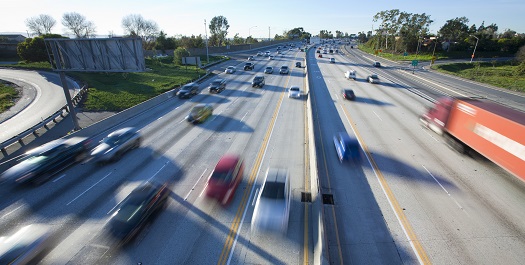By Joseph Averkamp, senior director of Technology, Policy, and Technical Strategy for Xerox Transportation
What is the best way to automate enforcement in high-occupancy vehicle (HOV) and high-occupancy toll (HOT) lanes? To answer that question, we ran pilot tests on the Xerox Vehicle Passenger Detection System (XVPDS) over the past 18 months. We’ve uncovered some impressive results.
Subscribe to email updates to receive the latest transportation industry trends and tips.
HOV and HOT lanes encourage carpooling, which can reduce traffic congestion in our cities. The obvious weakness is when motorists use these lanes even when they don’t have enough passengers in their cars. Our passenger detection system uses video analytics technology to count the number of passengers, and automated tools that deliver citations to people who violate the rules. During our pilots and presentations, we’ve been asked a lot of the same questions over and over again. They are great questions, and we present the answers here.
Can you outrun a traffic enforcement camera? Nope! 5 FAQs from Xerox #RideShare http://ctt.ec/v9jfg+
How do you manage privacy?
Facial images are redacted for privacy purposes, and we do not keep images of non-violators. There are two ways the images could be redacted: permanent or temporary. The option depends on the client’s goal and preference. All data is encrypted and stored locally.
Does XVPDS perform well in inclement weather?
We have noticed that the system’s 98.5 percent accuracy falls slightly in inclement weather. This is because of rain or other precipitation on the windshield that blocks the camera’s line of sight. For instances such as these, you have to ask, what is the alternative? The other option would be to have human counters standing outside in the cold or the rainy weather, trying to identify the number of passengers inside a vehicle. Through our pilot tests, we’ve noted that human counters are accurate only 35 percent of the time in good weather. (It’s not an easy task.) In our recent trial under rush hour conditions, human observers were challenged to score approximately 660 vehicles per hour, or 11 per minute. This means the human counters had to evaluate a vehicle every 5 seconds or so without a break for a three-hour stretch.
Clearly, this is a task that is performed better by a machine. Xerox VPDS is able to handle this level of activity without breaking a sweat. Compared to the 35 percent accuracy figure for humans, XVPDS is still the way to go. A compromised image would likely be caught in the review process and a fine would not be issued.
Could vehicles go by faster than the camera can catch them?
No, not really. When the system is properly configured, we can capture every vehicle whether they’re in stop-and-go traffic or moving 100 mph. Don’t try: It would be extremely dangerous to try and out-speed our system.
What if there’s a baby in the backseat, in a rear-facing car seat?
Our system identifies passengers by the line of sight, which means the system wouldn’t be able to see a baby in a rear-facing backseat. It would also be difficult for a human to see a baby in this position, too. An image like this would likely be caught in the back office by the reviewers and a fine would not be issued.
Can it detect the difference between a dummy and a human?
Yes, the system has done well detecting this trick in pilot tests, however we haven’t performed a dedicated study to determine its accuracy. During our pilots, we noticed that using a dummy, or another inanimate object, to try and trick the system is a rare occurrence. We’re always making improvements to XVPDS based on what we’ve learned in real-life scenarios. One thing we know for sure: Compared to human counters, the computers usually have the advantage. The system would truly be maximized for success if we combine the strengths of humans and machine by transferring human roadside counters to a position of XVPDS image reviewers.
Do you have a question regarding Xerox Vehicle Passenger Detection System? Send us an email at TLGMarketing@xerox.com and we’ll give you an answer.
Subscribe to this blog and receive email updates when we publish a new article.



When will you stop congestion by rewarding single occupancy hybrids from these lanes and enforce actual car-pooling instead of wasting resources on these actions?
Interesting comment, but your point is unclear to me. Removing single occupancy hybrids from the lane would improve congestion. Allowing single occupant hybrids in the HOV lane is a policy decision made by states and transportation agencies to encourage purchase of hybrids as they are viewed as being environmentally friendly. However, this policy does not encourage car-pooling so it does not favorably impact congestion. Xerox does not establish these policies but only offers tools such as Xerox Vehicle Passenger Detection System to the agency in an effort to improve compliance with the rules so that congestion is reduced. Also, the use of an automated system brings safety benefits since the system can reduce the number of stops a patrol officer has to make—traffic stops can expose officers and the driving public to risk. And the presence of an officer on the roadside can often create a new congestion issue—everyone rubbernecks to look at the police car and try to figure out what he/she is doing. Xerox doesn’t decide how the violations are enforced—the transportation agencies do—-but Xerox provides tools that enhance safety, reduce congestion, and improve compliance. How the agency utilizes the tools is a decision for government officials.
Quite interesting content! At first when I go through the title, I just could not figure out what the things are but reading it was really pleasure to me. Especially the 3rd & 5th point was the more interesting. I really did not know the things related to all these and really thankful to came to know it. Apart from the internet, a good service center or ASE certified mechanics can also provide valuable data regarding your vehicle that you never know about. I often collect auto updates from my service center: http://dellsservicecenter.com/
Because they are the people dealing with different cars everyday so they just have huge knowledge about these facts. Thanks for the post.
[…] L’article original de Joseph Averkamp a été initialement publié sur le blog Simplify Work […]
Hi, i think that i saw you visited my website thus i got here to return the want?.I’m trying to find things to improve my website!I
guess its adequate to make use of a few of your ideas!!
[…] help of the occasional image reviewer) spot HOV lane sneakers as they drive by. The system is named Vehicle Passenger Detection System and it works by using two cameras, an illuminator, a video image processor, and a laser […]